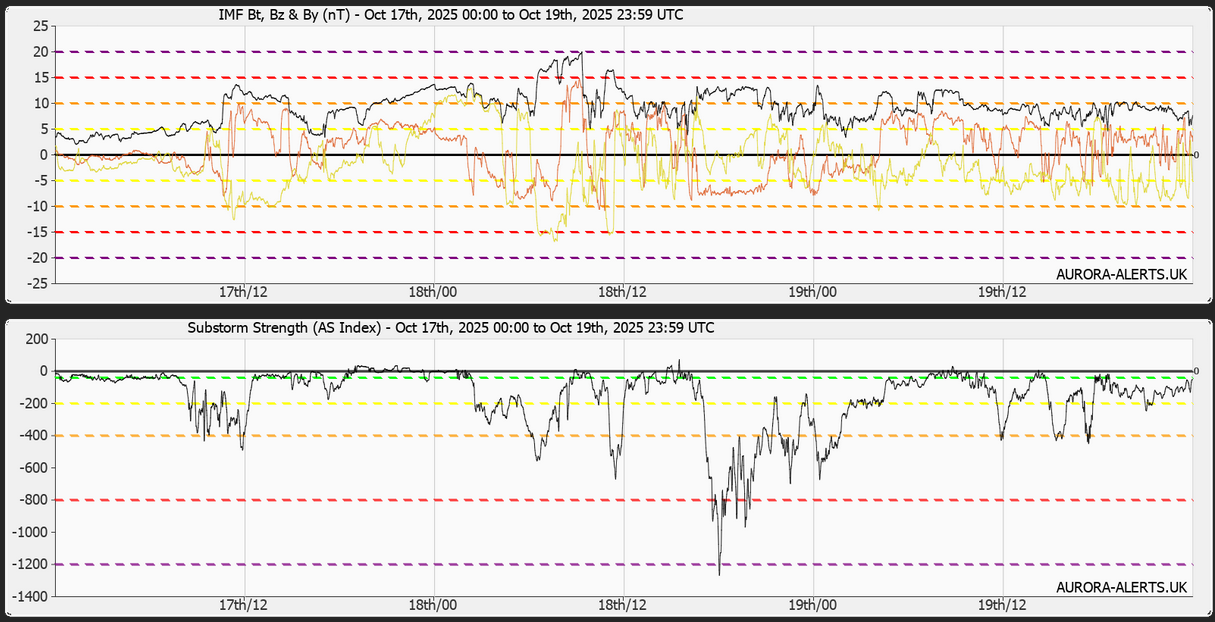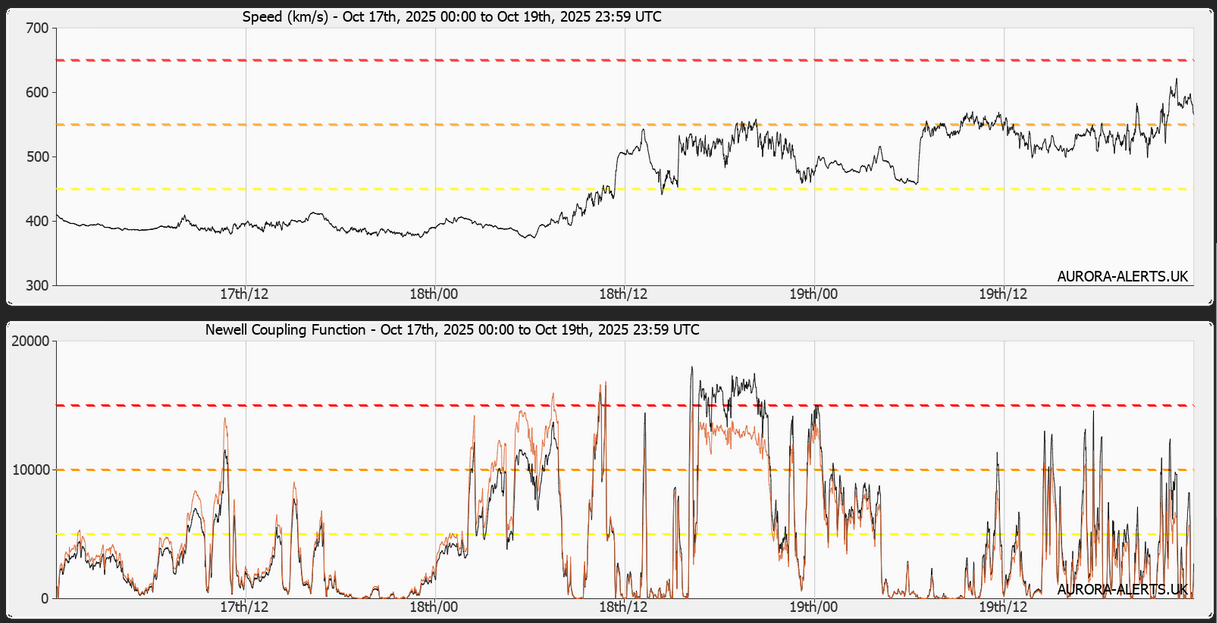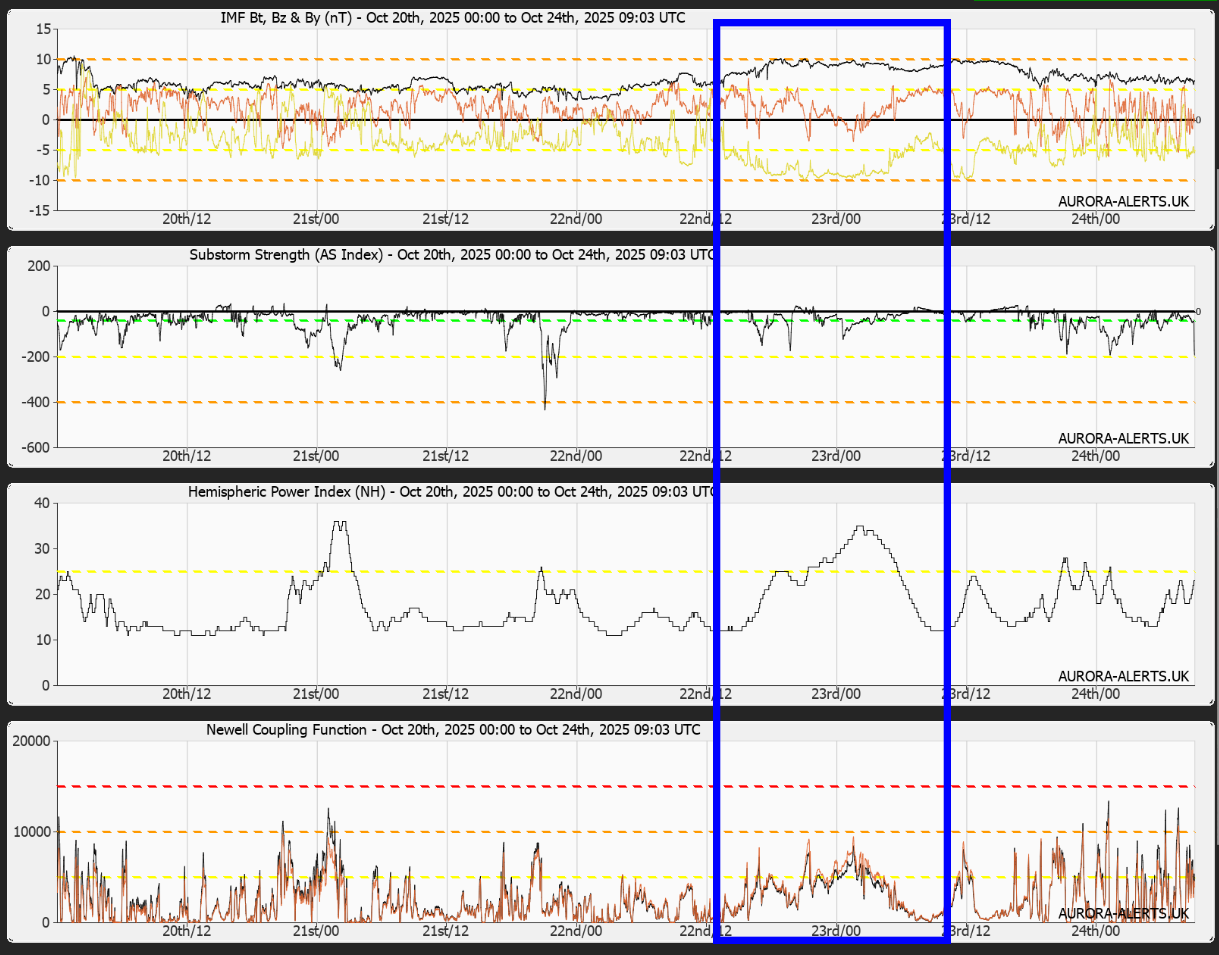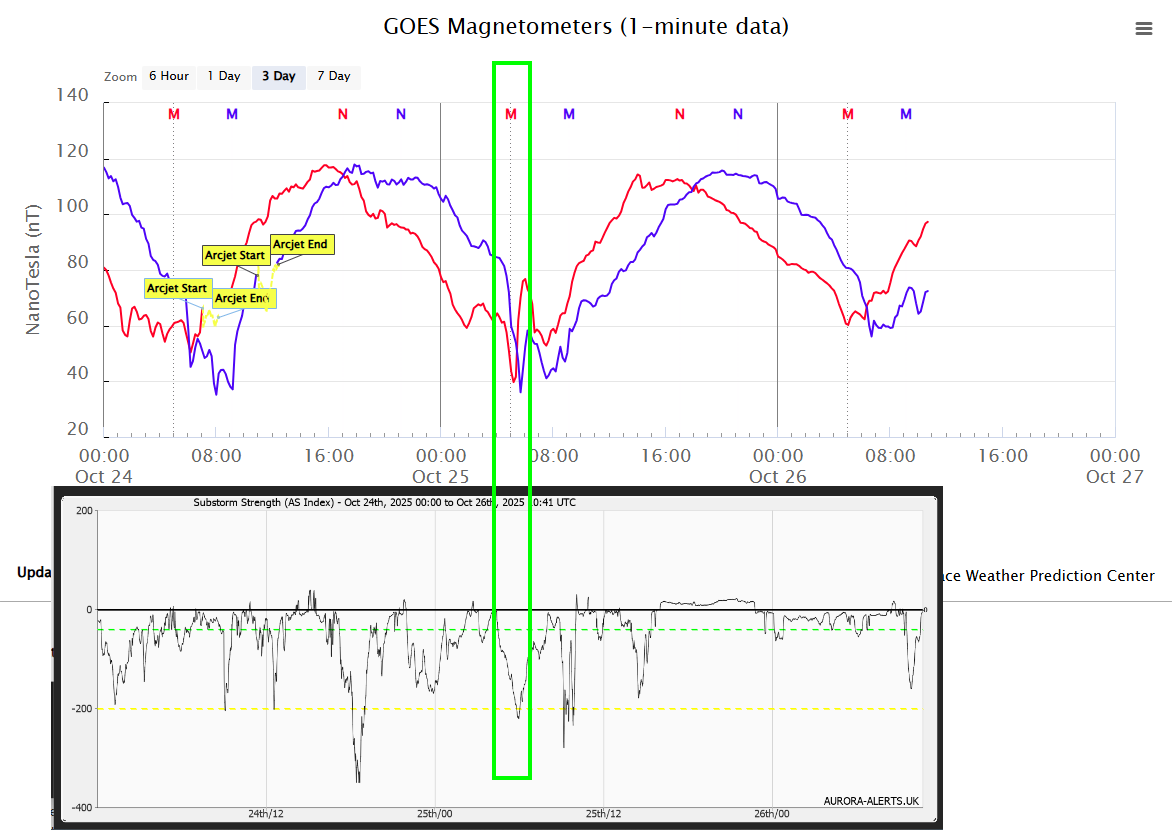Advanced FAQs from Glendale App
FAQs
BackSkip this section if you are just chasing auroras. This is just an explainer of some wider scientific terms and concepts. There is nothing here that you need to know to use Glendale App.
Magnetosphere
What's Magnetospheric Convection?
Magnetospheric convection is the scientific term for the transfer of energy from the IMF into the magnetosphere. Effectively, the charging of the battery or the growth phase for a substorm.
Academic literature will tell you that solar wind speed plus IMF Bt, By and Bz are the drivers of convection. This is not really true, as the only parameters needed to describe the convection process for a substorm are the IMF Bt and Bz at Earth. Speed is irrelevant.
What's Dipolarisation (Dipolarization, US)?
In substorm terms, dipolarisation is the opposite of convection. During magnetospheric convection, the Earth's magnetic field lines are stretched out like elastic bands into a tail, called the magnetotail, on the dark side of the Earth. Those stretched field lines want to relax and it is when they spring back to their normal, unstretched, dipole state that the stored energy is released, corresponding to the substorm expansion phase.
What are Loading and Unloading?
Loading and unloading are just alternative terms for convection and dipolarisation. During the growth phase, energy is being loaded into the substorm and later this unloads during the expansion phase.
The substorm strength index on Glendale App is the most accurate, real-time proxy for the amount of energy being unloaded during the expansion phase. By inference, it is also a proxy for how much energy was loaded into the magnetosphere during convection because what was unloaded must be roughly equal to what was loaded.
The image shows the pattern of loading and unloading of the magnetosphere over a 3 day period. You will notice how the substorms (drops on the substorm strength plot) correlate with the Bz (red line) going negative on the IMF plot.

When the Bz goes negative, magnetospheric convection starts. This is the growth phase of the substorm. A short while later, the substorm strength plot begins to drop negative. This is the substorm onset, the start of the substorm expansion phase. When the substorm strength is most negative, we have reached the peak of the substorm. It will then start to rise again as the substorm begins to recover. You can see on the plot that the substorm cycle repeats several times a day in response to the Bz going negative.
What is Steady Magnetospheric Convection (SMC)?
Steady Magnetospheric Convection is a mode that the magnetosphere switches into when the IMF Bz stays continually negative for more than one hour. It can sometimes last for many hours, even days.
SMC changes the behaviour of the substorm cycle. Normally, when the IMF Bz goes negative a substorm expansion will occur after approximately one hour of the Bz going negative at Earth. During SMC that changes to an average 3.5 hour interval.
A quiet auroral arc typically remains throughout SMC, with occasional bursts of rays on the expansions every few hours.
SMC is fantastic for beginners, as the quiet arc can last the whole night. It allows them to practice their camera skills, experiment with settings, compositions, foregrounds, locations, etc., without the time pressures of a more normal, explosive, expansion phase that might be over in minutes and a single mistake means you blew the opportunity.
Seasoned aurora chasers get bored of SMC. They want it to break.
Expansions will routinely occur during SMC but they are extremely difficult to predict. Sudden, sharp changes in the configuration of the IMF can also shake it out of SMC and induce a good show. Glendale App will tell you what time these will happen as soon as they become apparent in the data.
Coupling Functions
What are Coupling Functions?
Coupling functions are an academic confection. There are literally dozens of them. The idea is that you can create a function whereby you plug in parameters like speed and IMF values. It then tells you how much geomagnetic activity there will be, disguised as the amount of energy being transferred into the magnetosphere.
The academics test these by correlating the output against geomagnetic indices such as Kp, AE, etc.
The one regarded by the academics as being most accurate is called the Newell coupling function. It has this equation:
V4/3BT2/3sin8/3(θc/2)
Where V=speed, BT=Magnitude of IMF in YZ plane, θc=IMF clock angle.
The main uses of coupling functions, that you may have encountered, are Hemispheric Power Index (HPI), Polar Cap Potential (PCP) and Aurorasaurus use one they call 'storm tracker'.
HPI is based upon the Newell coupling function. It is used in SWPC's OVATION model. I've explained the issues with HPI already on the FAQ page. Aurorasaurus is based on one called the Akasofu Epsilon function.
There are three problems with coupling functions:
- The speed term.
- Assumption of direct driving.
- The By (clock) term
I have found no empirical evidence of speed as a driver of magnetospheric convection. Only IMF drives convection. The speed term is irrelevant.
If I plot Newell, as defined, and I also plot Newell but using a fixed speed of 450 km/s, to cancel out the speed term, the two plots are almost identical. The speed term is not really needed.
The image shows a plot of the raw Newell equation (black line) and Newell with a fixed speed of 450km/s, to cancel out the speed term (red line). Notice that the two lines only diverge slightly during extreme changes in the solar wind and it makes little difference to the predicted activity from the coupling function.

When I correlate these plots against substorm strength, I find that, with or without speed, they both perform the same as each other and equally badly against substorm data.
To be fair, Newell does appear to superficially correlate quite well with some bursts of substorm activity. This is because the clock angle term in the equation kicks in whenever Bz goes negative. The problem is the absence of any hysteresis in the equation. When Bz goes negative the coupling function instantly indicates a surge in activity / energy transfer. However, in the real magnetosphere there is a delay while the substorm enters its growth phase before later unloading the accumulated energy during expansion.
The clock angle term also causes problems for coupling functions. This is because, when Bz is positive, increasing By will cause the clock angle to increase. This in turn causes the coupling function to indicate increasing activity. Yet Bz is still positive, no convection is occurring and no substorm will happen.
The image shows an example of how By (bronze line) confuses the HPI and Newell coupling functions in the area marked with a blue box. There are a few tiny substorms during the period due to very short periods of negative Bz (red line). However, Newell and HPI both show a significant rise in predicted activity.

Some on social media will tell you that HPI is a measure of how much 'charge is going into the battery' and how far south the resulting aurora will be visible. It's worth understanding that the convection (charging) comes from the periods of negative Bz, not from HPI. Also, the viewlines are dependent on the strength of the substorm during its expansion phase (the drops on the above substorm graph), again not from the HPI. The substorms only last a few hours from beginning to end, whereas HPI would have you believe that hundreds of gigawatts of energy were being injected over long periods, up to 24 hours or more, without any resultant auroral activity. It is the energy being released during the short substorm expansion phase that is powering the aurora and making it visible at lower latitudes.
The best replacement for coupling functions is the Magnetosphere Model within Glendale App. This tracks the loading and unloading of the magnetosphere, accounting for hysteresis, and accurately predicts the times when the peak bursts of activity will occur. The substorm strength indicator on Glendale App is a real-time measurement of the magnetospheric response to the loading and unloading of energy from the solar wind IMF. Substorm strength indicator is not a coupling function or prediction. It is a direct measurement of changes to the Earth's magnetic field that occur during auroral substorms.
GOES Magnetometers
What are GOES Magnetometers?
GOES 18 and 19 are two geo-stationary satellites, one positioned over the east coast of the US and the other just west of the US mainland. They are around 42,000 km above the Earth's surface. Both carry magnetometers that measure the strength of the Earth's magnetic field.
What makes them interesting is that, when it gets dark in the US, these two satellites travel through the Earth's magnetotail and take measurements from directly within the magnetic soup stretched out on the dark side of the Earth.
American aurora influencers rave about GOES satellites being the best way to identify auroral substorm onsets. Unfortunately, there are MANY issues with trying to use GOES satellites for aurora-chasing:
- Cannot be normalised.
- Only work for North America.
- Miss most substorms.
- Often react late to substorms.
- False alerts.
- Proximity.
The main reason why ground-based, substorm tracking is more accurate is that ground-based magnetometers can be normalised. By normalising, we mean that we can pre-determine exactly what the station would read at any time on any quiet day. When readings start to deviate from those norms, we know exactly how far it has moved relative to what is normal. That tells us exactly how strong the deviation is and whether it is a weak or a strong substorm.
A GOES magnetometer cannot be normalised, as conditions are constantly changing within the magnetotail. We can only see whether the absolute field measurement is increasing or decreasing. We have no way to determine whether that reading is normal for that day/time or whether something unusual is happening. All we are able to do is look for sudden changes of direction or sudden rate changes. We cannot infer from the amount of change whether it is a weak or a strong substorm because we do not know what a normal amount of relative change is for those magnetometers.
When darkness starts to fall over the US, the GOES magnetometers start to pass into the magnetotail. This causes their absolute field measurement to slowly start to fall. The measurement continues to fall until the satellite reaches the middle of the magnetotail, where it measures its lowest reading at local midnight. The measurement then starts climbing again as the satellite continues travelling towards the opposite edge of the magnetotail and exits from it.
On a quiet night, without any substorms, the GOES plot will show a gentle fall towards local midnight and a gentle climb towards dawn. However, when a substorm happens while the satellites are passing through the tail then you will see abrupt changes in slope or direction of the plots.
The GOES satellites are very sensitive to their precise location within the magnetotail. Earlier or later during the US night, when they are at the edges of the tail, they can miss substorms entirely. They should only be used during darkness for North America, not for anywhere else in the world, because the satellites are only in the position needed to detect substorms when North America is on the dark side of the Earth.
If substorms are already being tracked on ground-based magnetometers, when GOES satellites turn into the middle of the tail, then the satellites can either miss the substorm entirely or react too late.
Just to make things even more complicated, the GOES plots often randomly make an abrupt change of direction for no reason whatsoever.
Another reason why ground-based, substorm tracking is more accurate is that the ground stations are passing directly underneath the auroral oval, only a few hundred kilometres from the actual aurora itself. The GOES satellites are around 42,000 km distant from the actual aurora. It's akin to holding up a thermometer in Tasmania and hoping to measure the temperature in Lapland.
Aurora hunters should always use the substorm tracker on Glendale App as their primary source of substorm information. Never pass up an active substorm on Glendale App to wait for a GOES magnetometer to do something. There's no harm in North Americans taking a few test shots if you do see a change on GOES but be prepared to fail.

The image above shows a comparison of Glendale App's substorm tracker against GOES magnetometers over a period of around 2.5 days. The section marked with a green box shows where GOES did actually detect a substorm because it occurred close to local midnight on the GOES magnetometers. However GOES missed all the other substorms over the period.
You may also be confused into thinking that GOES detected the onset ahead of the substorm tracker because the recoil on the GOES (red line) came before the peak of the substorm. However, the substorm onset is actually when the substorm tracker plot started to drop negative, not when the substorm peaked. The substorm tracker detected the onset before the GOES recoil*.
*If you have only used GOES magnetometers before and never used substorm tracking then you need to understand the fundamental difference in the way that you read the plots. On substorm tracker, the plot shows the strength of the substorm and tracks the entire substorm. When the line starts to drop from zero that is the substorm onset. When the line is most negative that is the peak of the substorm's expansion phase. When the line climbs again the substorm is starting into recovery. With a GOES plot, you cannot see the substorm, you are looking for a sharp recoil on the line to indicate that there might have been a dipolarisation and, therefore, a possible substorm onset.